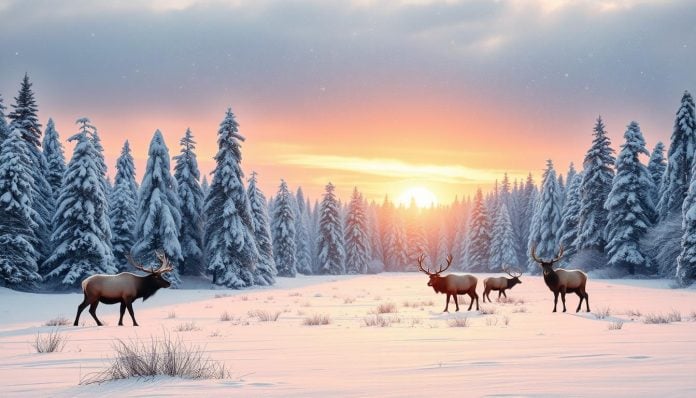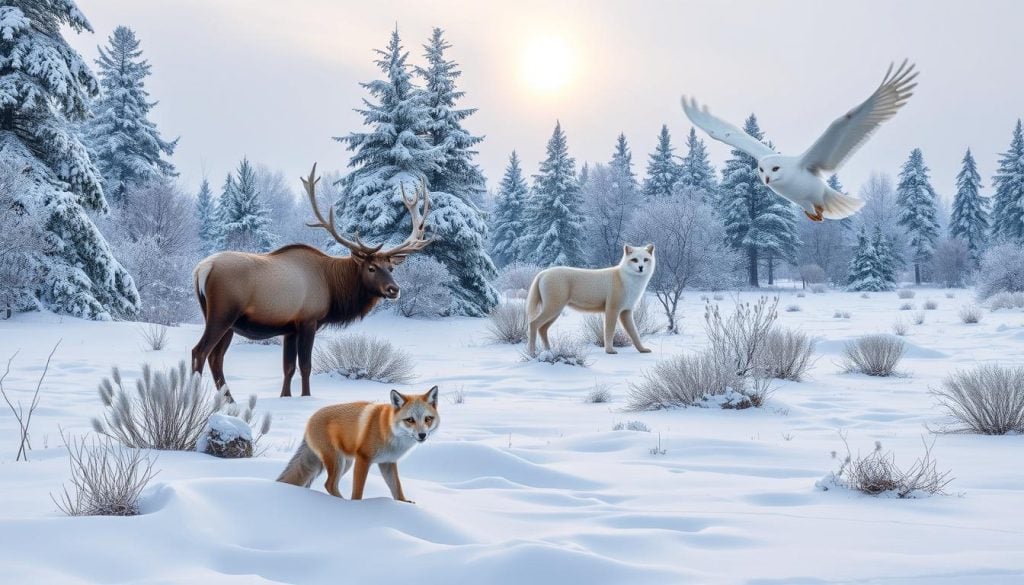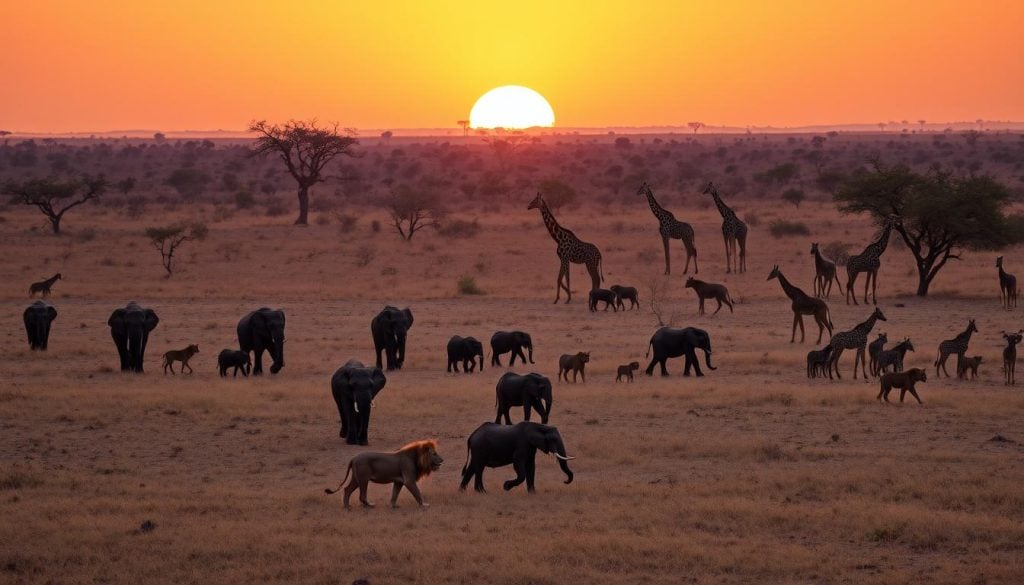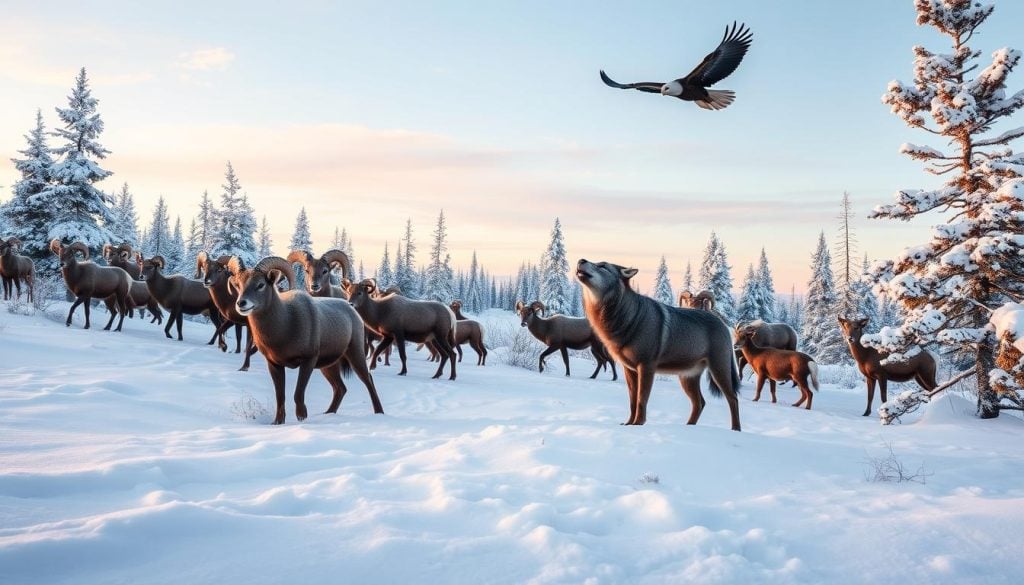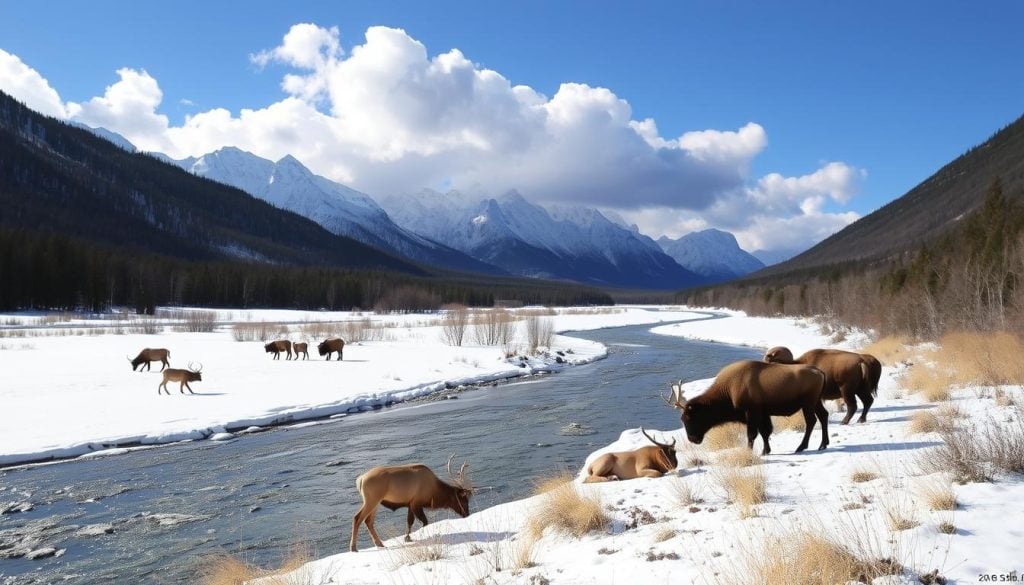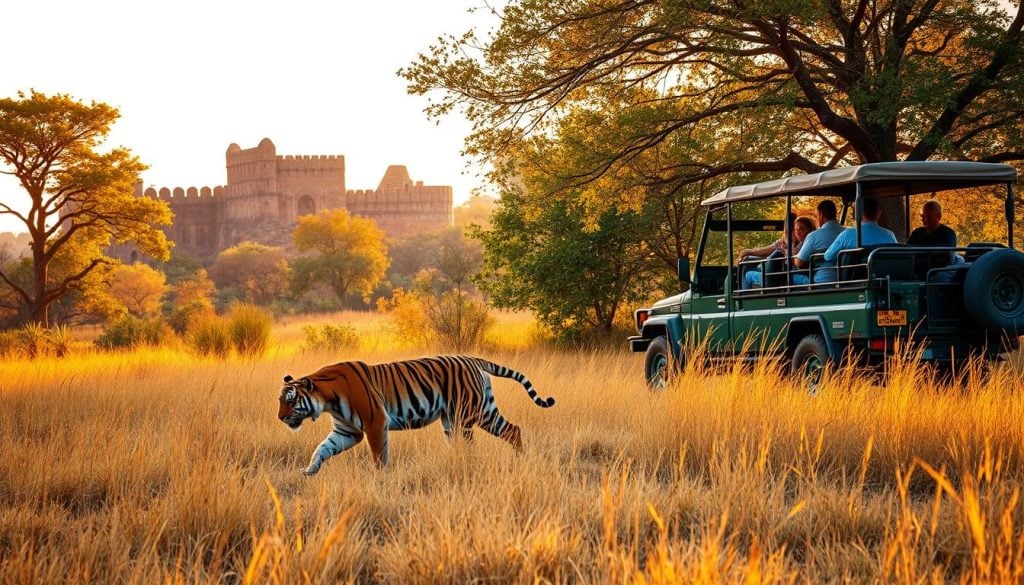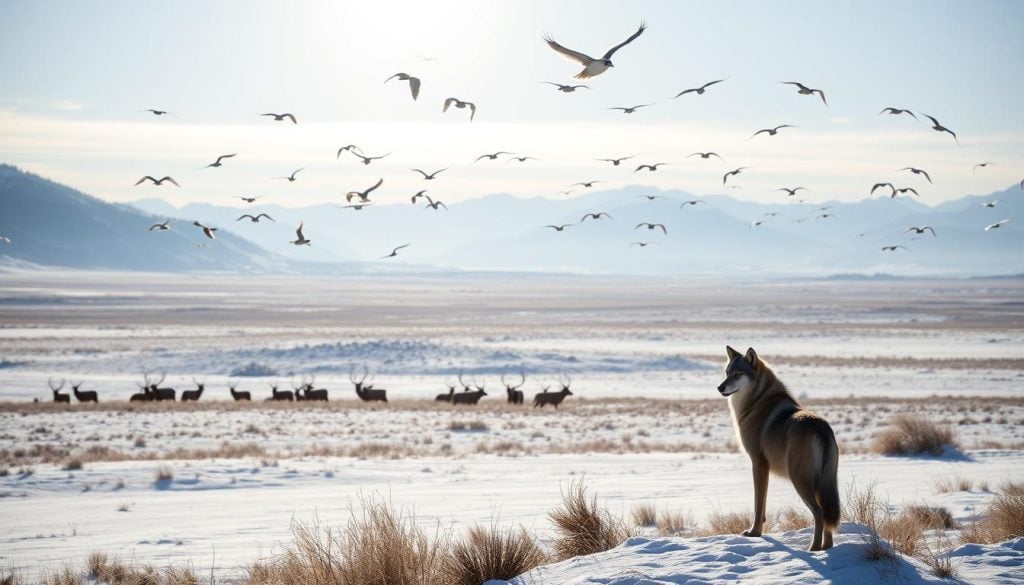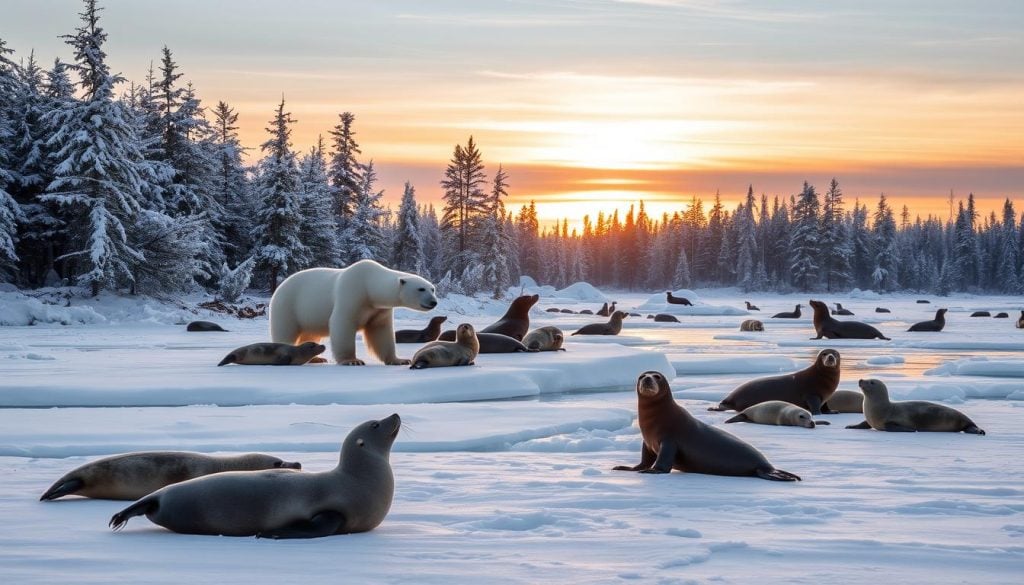Think a perfect safari only happens in summer’s warmth? Think again. Winter wildlife safaris bring extraordinary adventures. December brings unique adventures, making your wildlife viewing unforgettable. Imagine the Great Migration in Tanzania, or observing predators in the Serengeti. Perhaps enjoy whale watching in Sri Lanka’s scenic shores.
Winter, especially December, is great for December wildlife adventures. These safaris are not just scenic. They deeply educate on thriving wildlife, often with fewer crowds than summer. Let’s explore some top destinations and experiences. Discover why winter safaris are far from ordinary.
Introduction to Winter Wildlife Safaris
Winter wildlife safaris take you on an adventure among animals that love the cold. These trips let you see the calm beauty of snow-covered places. They also show how animals and nature change in winter.
These adventures are great for anyone, beginner or expert. You witness animals adapting to cold weather firsthand. Guides offer deep knowledge, turning these trips into learning experiences.
Grand Teton National Park is perfect for these safaris from November to April. Public safaris cost $305 per person for 2 to 8 guests. For more privacy, it’s $995 for 1 or 2 people, plus $175 for each additional person.
| Safari Type | Price | Guests |
|---|---|---|
| Public Safari | $305 per guest | 2-8 |
| Private Safari | $995 for 1-2 guests | Additional $175 per extra guest |
Pick-up times in the morning are between 7:00 and 7:30 AM. These locations are within Jackson and Teton Village. You’ll go on half-day or full-day guided tours. They offer a close look at animals like moose and elk in winter.
The Park Service says there are almost 1000 moose nearby, with about 200 in Yellowstone. The rest are in Grand Teton National Park.
In January and February, there’s a special 7-day Winter Wildlife Expedition. It costs $7895 for about 13 guests. Two leaders guide you, promising personal attention and high-quality service. This is backed by a promise of quality and a partnership with the World Wildlife Fund.
The beauty of cold weather wildlife excursions is unforgettable. These tours let you see animals at the start and end of the day. They capture the magical feel of winter like nothing else.
Top Destinations for Winter Wildlife Safaris
During winter, Africa and Yellowstone National Park are top picks for wildlife safaris. They are known for their stunning natural scenes and wildlife. Both places offer unforgettable experiences for those who love nature and adventure.
African Wildlife Safaris in December
In winter, Africa is the ultimate place for wildlife safaris. Kenya and Tanzania are especially busy. The Serengeti shows off the Great Migration. This time is perfect for seeing lots of newborn animals, attracting many visitors.
December is Africa’s dry season. It features mild days and clear skies. Wildlife gathers around water sources, making it easy to see them. You can see the Great Wildebeest Migration and Africa’s Big Five. These safaris in Africa are unforgettable.
| Highlights | Season |
|---|---|
| Great Wildebeest Migration | December to March |
| Big Five Sightings | June to October |
| Newborn Wildlife | December to March |
Yellowstone Winter Safari
Yellowstone turns into a winter wonderland. It is famous for its hot springs and geysers. Mammoth Hot Springs shows how amazing nature can be.
From December to April, Yellowstone offers winter tours. The snow makes it easy to see wildlife. People can safely watch wolves from the road in Lamar Valley. This is a special activity in the winter.
| Highlights | Season |
|---|---|
| Wolf Viewing in Lamar Valley | December to April |
| Grizzly and Wolf Interactions | March to April |
| Geothermal Features | Year-Round |
A winter visit to Yellowstone means seeing elk and bison at lower elevations. Private tours make the experience better. High-resolution spotting scopes improve viewing. Yellowstone is perfect for those who love nature in winter.
The Magic of Yellowstone Winter Safaris
Winter transforms Yellowstone National Park into a different world. It becomes a quiet yet exciting place for those who love wildlife. Animals like elk and bison move to lower areas, making them easy to see. Winter also brings unique views of animals and predator behavior that you won’t see anywhere else.
Elk and Bison in Lower Elevations
In winter, finding elk and bison is easier because they head to places where they can find food. This moving of the animals is a special part of Yellowstone in winter. Seeing these big animals in the snowy landscape is unforgettable.
Tracking Predators
The winter also lets you see wolves and mountain lions hunting. Watching these top predators in action shows the beauty of nature. Wolves, brought back to the park in 1995, moving through the snow is a highlight. Their hunt is a story of survival that you can witness on a safari.
| Tour Feature | Details |
|---|---|
| Duration | 2-day winter tour |
| Lodging | 1-night lodging included |
| Visits | Lamar Valley, North Entrance at Mammoth |
| Drive Time | 1 1/2 hours from Bozeman to Yellowstone |
| Local Population | Population of about 150 in Cooke City, Montana |
| Wildlife Sanctuary | Wolf & Grizzly Discovery Center |
| Included Amenities | Snacks, hot/cold refreshments, lunches, dinner |
| Equipment Provided | Binoculars and spotting scopes |
| Guide Services | Professional guides included |
Unique Winter Wildlife Safaris in Africa
Most think of Africa as a place of hot, dry savannahs. Yet, in winter, or the green season, places like the Kalahari and the Serengeti turn into rich areas full of wildlife. These landscapes offer unmatched wildlife experiences. This makes Africa a top spot for special winter safaris.
Green Season in the Kalahari
The Kalahari Desert changes into a lively oasis during the green season. The dry land suddenly bursts with greenery, drawing in various animals. You can see zebras, wildebeest, and many birds coming for water and food. This time also brings amazing chances to see the habitat in a way only Africa can show.
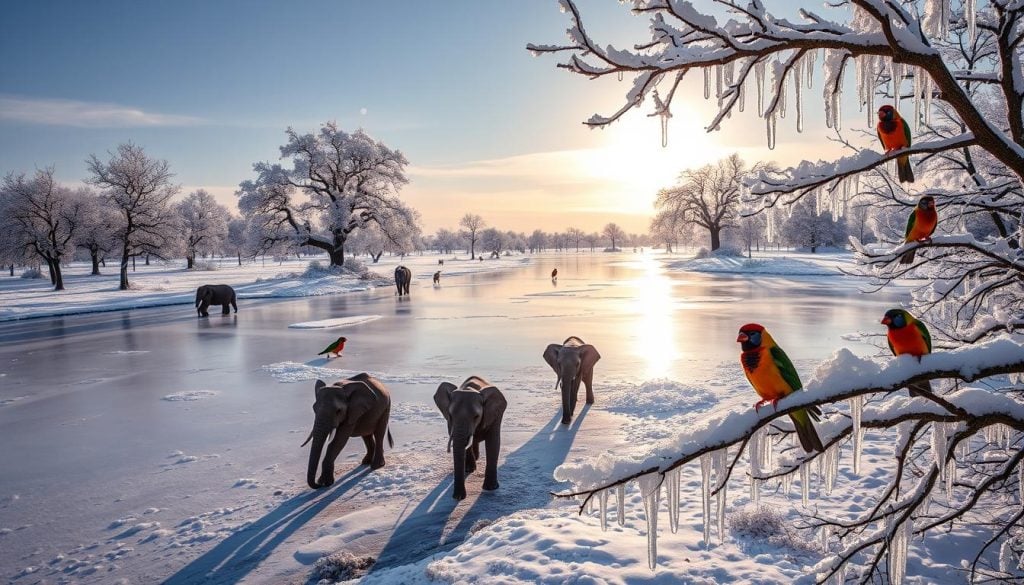
Serengeti and Ngorongoro Crater
The Serengeti and Ngorongoro Crater in Tanzania are great for wildlife watching in the winter. The Ngorongoro Conservation Area is home to around 25,000 large animals during this time. It’s the best time to see the great wildebeest migration. Millions of animals move across the land, followed by hungry predators. It’s a powerful show of nature.
| Destination | Unique Winter Experience |
|---|---|
| Kalahari Desert | Green season with zebras, wildebeest |
| Serengeti | Wildebeest migration, predator-prey sightings |
These places in Africa show that winter safaris are not just about snow and ice. They’re also about diving into areas going through their own time of growth and plenty. Winter here really captures what it means to explore frozen habitats, even in the middle of Africa’s lush settings.
Exploring Grand Teton National Park
Grand Teton National Park offers amazing outdoor winter wildlife experiences. With stunning views of snow-capped peaks and a quiet snow-blanketed landscape, Grand Teton nature tours are a top choice for winter safaris.
These tours are carefully designed to give participants a great experience. Each safari is about 4 hours long. They can happen at sunrise or sunset, when animals are most active.
For public safaris, prices start at $170 per person, not including taxes and fees. Private safaris cost $645 for up to two guests. Each additional guest costs another $85.
Safari groups are small, with no more than 8 guests. This ensures a personal experience. Guides provide tailored experiences, teaching about local ecology, animal behavior, winter adaptations, snow science, geology, and cultural history.
| Safari Type | Price | Max Group Size | Pick-Up Time | Duration | Age Requirement |
|---|---|---|---|---|---|
| Public Safari | Starting at $170/guest | 8 guests | 7:00 AM – 7:30 AM (morning), 1:00 PM – 2:30 PM (afternoon) | 4 hours | 8 years old |
| Private Safari | $645 for 1-2 guests, $85 for each additional guest | 7 guests | Customizable | 4 hours | No minimum age |
Guests are picked up and dropped off at their lodging in Jackson and Teton Village. This makes travel easy. Sunrise and sunset tours are great times to see wildlife like moose, elk, bison, bighorn sheep, mule deer, wolves, bald eagles, and trumpeter swans.
These well-thought-out outdoor wildlife experiences in Grand Teton National Park give participants a memorable adventure in a beautiful setting.
Safari Adventures in Botswana
Botswana boasts of amazing safari experiences. The winter season reveals its wonders, making it the best time for safaris. With varied landscapes and plenty of wildlife, adventures here are unique and unforgettable.
Okavango Delta’s Winter Wonders
Winter transforms the Okavango Delta. This UNESCO site covers 15,000 sq kms. It’s home to various plants and animals. It becomes the heart of Okavango Delta exploration.
Winter is dry, drawing 200,000 large mammals here. You’ll see hippos, elephants, and even rare antelopes. The delta also supports many birds. Birdwatching here is incredible.
Mokoro safaris let you silently move through waterways. This way, you can see wildlife closely. It’s a unique part of your adventure.
Chobe National Park
Chobe National Park is perfect for winter safaris. It’s famous for many elephants. Visitors enjoy game drives there.
Animals gather at water sources, and you might see predators like lions. Chobe has four national parks and six reserves. They offer diverse safari experiences.
A week-long safari helps you explore fully. Lodges, like Savuti Camp, provide luxury and family options. They ensure a comfortable experience.
Here’s a detailed table outlining some essential facts about Botswana safaris:
| Attribute | Details |
|---|---|
| Peak Booking Time | 10 to 12 months in advance |
| National Parks and Game Reserves | 4 National Parks, 6 Game Reserves |
| Key Wildlife Species | Elephants, Hippos, Crocodiles, Lions, Leopards, Rare Antelopes |
| Typical Safari Duration | 7 to 12 days |
| Lodge Amenities | Private plunge pools, Massage parlors, Small gyms |
Botswana remains a top choice for winter safaris. Its unmatched wildlife and luxury stays offer a unique experience. Whether exploring the Okavango Delta or game driving in Chobe, winter promises unforgettable safaris.
Winter Wildlife Safaris in Sri Lanka
Sri Lanka becomes magical in December. Its lands and seas offer perfect views of vibrant wildlife. On the island, whales play in the waters. On land, national parks are full of animals in the green foliage.
Whale Watching
December brings an extraordinary chance to see whales in Sri Lanka. The Indian Ocean’s southern coast is bustling with blue whales. Tours often start from Mirissa or Trincomalee, letting people get close to these sea giants.
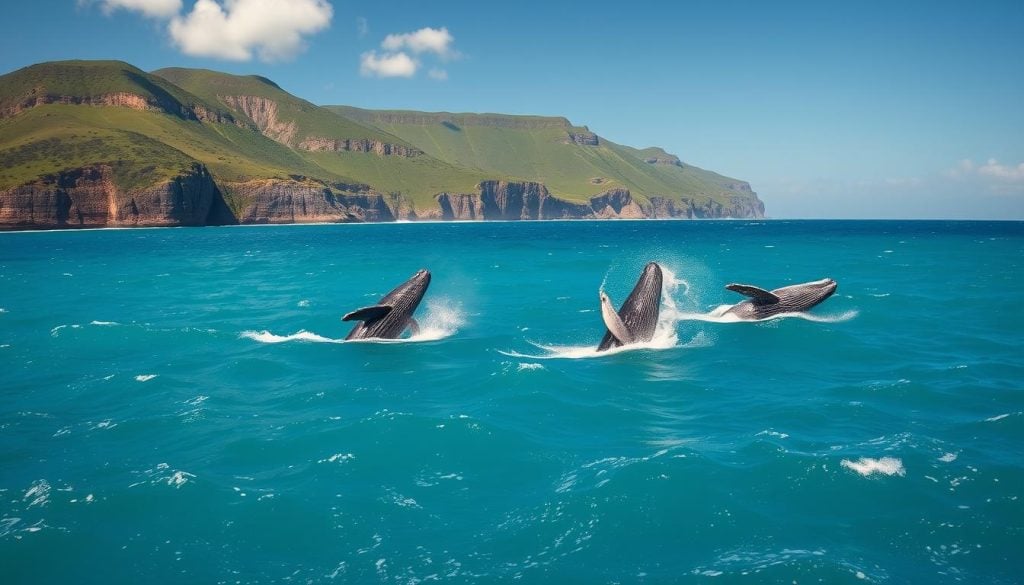
It’s not just blue whales; there are sperm whales, fin whales, and dolphins too. Sri Lanka, with its seasonal marine life, is perfect for experiencing whale watching.
Yala National Park
Yala National Park safaris attract many with the world’s highest leopard numbers. It’s a dream site for those who love big cats. But there’s more than just leopards.
Yala’s habitats are home to elephants, sloth bears, and different birds. The park offers adventures through forests and along beaches. Every safari reveals a bit more of the natural world Yala protects.
Here’s a detailed plan of the safari tours:
| Tour Length | National Parks Visited | Night Stays |
|---|---|---|
| 12 days / 11 nights | Sinharaja, Horton Plains, Yala, Bundala |
|
Uda Walawe National Park is famous for its elephants. You might also see jackals, crocodiles, and deer. Bird watchers can spot eagles and pelicans. The Elephant Transit Home helps orphaned elephants, adding a special touch.
Sri Lanka hosts unforgettable wildlife safaris during winter. Its unique habitats make it a top choice for nature lovers.
Experiencing Wildlife Safaris in India
Explore the exciting world of wildlife with a Ranthambore National Park safari in Rajasthan. It is known for its Bengal tigers. The park is ideal for wildlife viewing from October to March. Its green landscape makes every moment memorable under the Indian sun.
Jim Corbett National Park in Uttarakhand is India’s oldest. Covering 1300 sq. km with 8 zones, it’s great for safaris in winter. The area teems with diverse plants and animals across vast lands.
Kaziranga National Park in Assam is a UNESCO site perfect from November to April. With grasslands and forests, it hosts many species.
In Karnataka, Bandipur National Park sits in the Nilgiri Biosphere Reserve. Winter is best for seeing Indian elephants, gaurs, and perhaps leopards. The cool weather increases your chances of magnificent sightings.
Sundarbans National Park in West Bengal has the largest mangrove forest. Its best in cool, dry winter months. The dense forests and waterways promise a unique safari thrill.
Gir National Park in Gujarat is famous for Asiatic lions. From November to March, you can see these lions in the wild.
Periyar National Park in Kerala offers beautiful views and wildlife in the Western Ghats. Winter, especially from November to February, is great for possibly spotting tigers or leopards.
Tadoba Andhari Tiger Reserve in Maharashtra is a hidden treasure in winter. Here, seeing tigers, leopards, and sloth bears is likely. Its charm makes it special for wildlife lovers.
Rajaji National Park in Uttarakhand welcomes visitors from November to June. Its diverse landscapes support rich wildlife, making safaris exciting.
Kabini Wildlife Sanctuary in Karnataka is a biodiversity hotspot. Visit from October to February and mid-March to May. Jhalana Leopard Safari in Rajasthan is known for its leopards, often seen by visitors.
Pench National Park in Madhya Pradesh is famous for Royal Bengal tigers. The best time for a visit is from November to February. Its unique landscapes offer a rich variety of species, enhancing each moment.
Adventures in the Greater Yellowstone Ecosystem
The Greater Yellowstone Ecosystem is full of winter adventures that thrill and teach. Its stunning winter scenery makes it a paradise for lovers of nature and excitement. Anyone longing for winter adventures in Yellowstone will find this ecosystem fulfilling.
Winter Wildlife Viewing in Lamar Valley
Lamar Valley is known as the “Serengeti of North America” because of its rich animal life and great wildlife viewing. Winter adds a special beauty here, with a quiet snow cover. This makes spotting animals magical yet a bit challenging. In winter, fewer crowds mean you can get closer to wolves, bison, and elk.
| Tour Type | Duration | Activities |
|---|---|---|
| Half-Day Interpretive Tour | 4 Hours | Wildlife viewing, ecology education |
| All-Day Interpretive Tour | 8 Hours | Includes lunch, extensive wildlife viewing |
| Private Interpretive Tour | Custom | Tailored experiences, private guide |
Snowshoeing Expeditions
Snowshoeing is an adventure that beautifully mixes excitement with peace in the snowy wilderness of the Greater Yellowstone Ecosystem. Guides take you through untouched spots. You see the winter beauty up close. Wildlife Expeditions’ expert guides have been leading since 1999. They ensure you enjoy the sights and learn about local ecology and history. They also talk about how wildlife copes with winter.
These trips include visiting places like Old Faithful, the Grand Canyon of Yellowstone, and Yellowstone Lake. You learn a lot about the area’s plants, animals, and rocks. The experience comes with transport, a deli lunch, and snacks from a local bakery. Remember to wear layered clothes because temperatures swing from very cold to moderately cold. Snowshoeing is a must-do for winter adventures in Yellowstone!
Tours run from December to April. Late winter, from March 15 to April 1, is the best time for those eager to see grizzly bears and wolves.
The Benefits of Winter Wildlife Safaris
Winter wildlife safaris offer unforgettable intimate nature experiences. This season sees fewer tourists in Africa, making your adventure more personal and exclusive. You’ll enjoy quieter safari camps, lodges, and sites, with top-notch service and attention.
The winter months let you witness the Serengeti and Masai Mara migrations. This incredible movement of animals is one of the world’s Seven Natural Wonders. It’s a spectacular sight that other seasons just can’t match.
Boating and canoeing add a unique touch to winter safaris. In Botswana’s Okavango Delta, mokoro canoeing gets you close to hippos, elephants, and more. The peaceful late afternoon ventures, under the African sunset, are ideal for photography. Plus, these activities are quieter and offer a deeper nature connection now.
In places like South Africa’s Eastern Cape, winter is mild and dry, with comfy 24-degree days. This weather decreases aggressive wildlife behavior and improves nocturnal animal sightings. Less rain also means animals gather at water holes, giving clear views of these majestic creatures.
Winter wildlife safaris are filled with advantages, from low costs to unique natural spectacles. Enjoy fewer tourists, better visibility for animal tracking and photos, and a calm, snowy setting. These experiences make winter an ideal time to explore the wild.
Preparing for Your Winter Wildlife Safari
Getting ready is crucial for a great winter wildlife safari. Essential gear and booking tips are key. A complete safari preparation guide will make your trip comfortable and memorable.
Essential Gear
To enjoy your wildlife trip, you need the right gear. Here’s what you should have:
- Layered Clothing: Wear layers to adjust to changing temperatures.
- Warm Footwear: Insulated boots keep your feet warm. A portable boot dryer, like the Versadri 12V Portable Dryer, is handy.
- Binoculars: They are a must for seeing animals from afar.
- Camera: Bring a camera with a good lens to capture stunning moments.
- Bear Spray: Important for safety in bear territories.
- Navigation Aids: Use GPS or maps to find your way in remote places.
- Hydration and Snacks: Stay energized and hydrated.
Booking Tips
Planning your wildlife trip well means booking early. Here are some tips:
- Timing: Look for animals in the early morning or late afternoon.
- Guided Tours: Choose tours with expert guides, like Teton Wild Custom Wildlife Tours, for a better learning experience.
- Accommodations: Pick a place to stay in Jackson Hole that fits your needs and budget.
- Vehicle Rentals: Get a vehicle for the snow. SUVs cost more but are best for snowy roads, with prices between $40 to $150 a day.
- Road Closures: Check for closed roads in places like Yellowstone or Grand Teton to avoid problems.
To have a successful safari, follow a safari preparation guide closely. Plan for critical wildlife trip aspects. Remember to always show respect to the animals and their homes. This makes your adventure more meaningful.
Conclusion
Winter wildlife safaris are an adventure like no other. They let you see animals in their natural habitats, making unforgettable memories. At places like Yellowstone and the Serengeti, you can see animals behaving in amazing ways. Animals like the red fox and the Great Horned Owl show how well they can live in the cold.
You’ll also see migrations of snow geese and tundra swans. Plus, you can watch river otters and bald eagles up close. It’s a chance to see nature’s wonders firsthand.
These safaris help save animals too. By traveling responsibly, you support wildlife conservation. Seeing tigers in Bandipur or rhinoceroses in Kaziranga teaches the value of eco-friendly travel. This way, we make sure these adventures are here for future generations.
Safaris also connect us deeply with nature. The winter scenery of icy ponds and snowy fields is stunning. With the right equipment and respect for wildlife, these trips leave lasting impressions. Whether you’re following wolverines in Jackson Hole or watching predators in the Kalahari, winter is perfect for seeing wildlife in its glory.

































